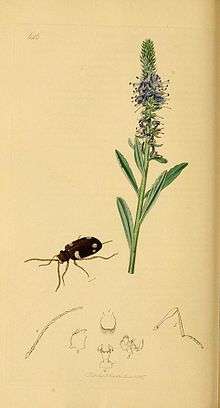Ptinus sexpunctatus
Ptinus sexpunctatus is a species of beetles in the genus Ptinus of the family Ptinidae.[1] It is commonly known as the six-spotted spider beetle.

| Ptinus sexpunctatus | |
|---|---|
 | |
| Ptinus Sexpunctatus caught on a sticky blunder trap in the Yorkshire Museum | |
| Scientific classification | |
| Kingdom: | Animalia |
| Phylum: | Arthropoda |
| Class: | Insecta |
| Order: | Coleoptera |
| Family: | Ptinidae |
| Genus: | Ptinus |
| Species: | P. sexpunctatus |
| Binomial name | |
| Ptinus sexpunctatus Panzer, 1789 | |
Taxonomy
P. sexpunctatus is one of eleven species of Ptinid in the subgenus Gynopterus. The subgenus was first described by Mulsant and Rey in 1868.[2]
Description
The species is approximately 4–5 mm in length and is a uniform dark colouration. It has very prominent basal and apical patches of appressed white scale. The grooves on the elytra are very deep. [3]
Distribution and Habitat
Ptinus sexpunctatus is a Palearctic spider beetle (Ptinidae: Ptininae) found throughout Europe.[1] In the United Kingdom it is categorised as 'Nationally Notable B' by the National Biodiversity Network and thus appears in between 31-100 hectads (10 km grid squares) across the country.[4] In 2007 it was first recorded as an invasive species in North America where it may have imported with introductions of Osmia cornuta and Osmia cornifrons.[1]
The six-spotted spider beetle has been generally associated with pine forests,[5] although more cosmopolitan sightings have occurred indoors.[6][7][8] The larvae of P. sexpunctatus are commensals in the nests of cavity-nesting solitary bees in the genera Osmia and Megachile.[1] One example has been recorded, from Nova Scotia, Canada, in the nest of the Blue Orchid Mason Bee (Osmia lignaria).[3] Within the nest, the larvae feed on the food provisions of the host larva.
The prevalence, or at least the recording, of P. sexpunctatus may be increasing due to the rise in the number of commercially available bee hotels used in domestic gardens.[9]
External links
References
- Majka, C.G., Philips, T.K., and Sheffield, C. 2007. "Ptinus sexpunctatus Panzer (Coleoptera: Anobiidae, Ptininae) recently recorded in North America", Entomological News 118 (1), 73-77.
- Mulsant, E.; Rey, C. (1868). Histoire Naturelle des Coléoptères de France. Deyrolle.
- Majka, C. (2004). "Ptinus sexpunctatus Panzer". Retrieved 2015-08-10.
- National Diversity Network (2015). "Ptinus sexpunctatus Panzer, 1792". Natural History Museum. Retrieved 2015-08-10.
- Franc, N (2007). "Observationer av nästtjuvbaggen, Ptinus sexpunctatus, Panzer 1795" (PDF). Entomologisk tidskrift. Retrieved 2015-08-08.
- Smith, K.G. (1995). "Ptinus sexpunctatus Panz: (Col. Ptinidae) indoors in North London (Middlesex)". Entomologist's Monthly Magazine. 131: 105.
- Jones, R.A. (1996). "Ptinus sexpunctatus Panz. (Col. Ptinidae) indoors in south London (Surrey)". Entomologist's Monthly Magazine. 132: 304.
- Parker, A. (2015). "Ptinus sexpunctatus in the Yorkshire Museum". Bulletin of the Amateur Entomologists' Society. 74: 180–181.
- Mendel, H. (2017). "Is Ptinus secpunctatus Panzer (Ptinidae) becoming more common as a result of 'bee hotels' in gardens?". The Coleopterist. 26 (3): 156-157.